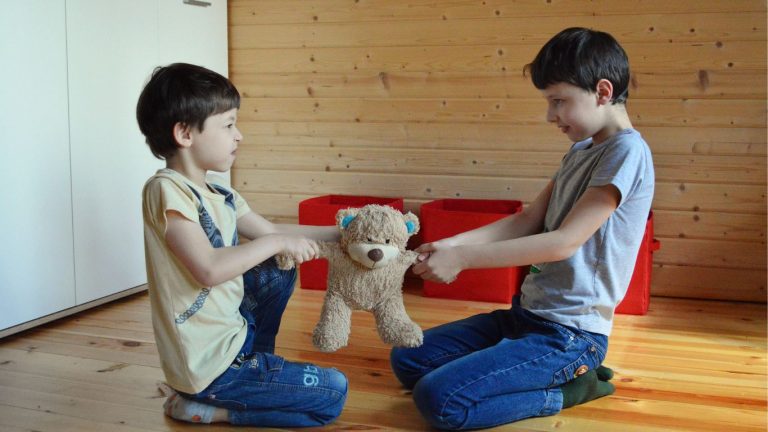Just the other evening, I found myself in the middle of yet another classic showdown between my two teenage daughters, Lucy and Hannah. Lucy, who’s sixteen, had borrowed Hannah’s favourite top without asking, and it didn’t take long for Hannah, fourteen, to notice. As soon as Hannah saw Lucy wearing it, she exploded, accusing her sister of always taking her things and never respecting her space. Lucy, in true teenage fashion, rolled her eyes and retorted that it was just a top and not the end of the world. The argument quickly escalated, with both girls trading barbs and bringing up past grievances. As I stepped in to mediate, I realised, once again, how complex sibling rivalry can be, especially during these tumultuous teenage years.
Note: We learned (and tested) the majority of these tips from my good friend and parenting expert Amy McCready.
Causes of Sibling Rivalry
Sibling rivalry is something every parent deals with at some point. It’s normal and even inevitable. But understanding why it happens can help you manage it better. Sibling rivalry often stems from jealousy, competition, and conflicting needs. Sometimes, it’s just a way for kids to connect or gain attention from you.
Developmental Stages and Rivalry
Kids go through different developmental stages, and these can impact how they interact with their siblings. For example, a younger sibling might feel overshadowed by an older one who can do more things. This can lead to feelings of jealousy and rivalry. I remember when my baby was born, my older daughter suddenly started acting out. It was her way of coping with the new family dynamic.
Parental Attention and Competition
How kids perceive they’re treated by parents plays a big role in sibling rivalry. If one child feels they’re not getting enough attention, it can cause strain. I noticed that when I spent more time with my older child, my younger one would act up. Balancing your attention can be tricky but is crucial for happy siblings.
Personality Differences
Every child is unique, and their individual temperaments can clash. One might be more laid-back while the other is more high-strung. These personality differences can lead to sibling conflict. My older sister and I were like chalk and cheese growing up, always bickering because we saw the world so differently.
Understanding the roots of sibling rivalry can help you address it more effectively. It’s not about eliminating the conflict entirely but managing it in a way that fosters a loving and supportive environment for your children.
Favoritism (Perceived or Real)
Favoritism can be a significant cause of sibling rivalry, whether it is perceived or actual. When one child feels that their sibling is being favoured, it can lead to intense feelings of jealousy and resentment. This perception can stem from a variety of sources:
- Unequal Attention: If one child receives more attention due to special needs, talents, or circumstances, the other child may feel neglected and develop negative feelings towards their sibling.
- Parental Bias: Sometimes, parents might unconsciously favour one child over the other based on shared interests or personality traits. Even subtle differences in treatment can be keenly felt and lead to rivalry.
- Rewards and Discipline: Disparities in how parents reward or discipline their children can also fuel feelings of favoritism. If one child perceives that their sibling is getting away with more or receiving more praise, it can create conflict.
- Comparison: Constantly comparing siblings can foster rivalry. Statements like “Why can’t you be more like your sister?” can damage a child’s confidence and pit them against each other.
To manage this, it’s crucial for parents to strive for fairness and recognise each child’s unique strengths and needs. Open communication and reassurance can help mitigate feelings of favoritism.
External Stressors (e.g., Divorce, Financial Difficulties)
External stressors such as divorce or financial difficulties can exacerbate sibling rivalry. These stressors impact the family dynamic and can heighten tensions between siblings for several reasons:
- Emotional Stress: Events like divorce can cause significant emotional turmoil for children. They might project their frustrations and insecurities onto their siblings, leading to increased conflicts.
- Resource Scarcity: Financial difficulties can lead to a perceived or actual scarcity of resources, whether it be parental attention, material possessions, or opportunities. This scarcity can fuel competition and rivalry.
- Changes in Family Structure: Divorce often brings about changes in living arrangements and family roles, which can be disruptive and lead to rivalry. Siblings might compete for time and attention from each parent, especially if they are living in separate households.
- Parental Stress: Parents under stress may inadvertently transfer their anxieties to their children. A stressed parent might be less patient and more prone to favouritism or unfairness, further aggravating sibling rivalry.
Common Signs and Symptoms
If you’re wondering whether what’s happening at home qualifies as sibling rivalry, look for these signs:
- Constant Bickering: Frequent arguments and disagreements are a clear indicator.
- Jealousy: One child may feel envious of the other’s achievements or attention.
- Competition for Parental Affection: Siblings might vie for your attention and approval, often leading to conflicts.
These are not just passing phases; they’re indicators that your children are trying to find their own place in the family hierarchy. Recognising these signs early can help you manage them effectively and ensure a harmonious home environment.
Impact of Sibling Rivalry
Emotional and Psychological Effects
As a mum, I’ve seen firsthand how sibling rivalry can stir up a range of emotions, from jealousy to resentment. It’s not just about who gets the last piece of cake; it’s about feelings of worth and love. Children can carry these emotional scars into adulthood, affecting their self-esteem and relationships. It’s crucial to address these issues early, offering support and understanding to each child.
Effects on Family Relationships
The dynamics within a family can be significantly strained by sibling conflicts. Family gatherings might become battlegrounds, with parents often caught in the middle trying to mediate disputes. This can lead to a stressful atmosphere at home, where instead of support and relaxation, there’s tension and anxiety. Encouraging open communication and fairness can help alleviate some of these pressures.
Long-term Consequences
The long-term impact of sibling rivalry shouldn’t be underestimated. Adults who grew up in highly competitive sibling environments might struggle with issues like depression and anxiety. They might also have trouble forming their own healthy relationships. It’s essential for parents to foster a nurturing environment that promotes cooperation over competition, helping to pave the way for healthier future relationships for all children involved.
Effective Communication Strategies to Deal with Sibling Rivalry
Active Listening Techniques
One of the most important skills you can teach your children is active listening. This means really paying attention to what the other person is saying without interrupting. I remember when my two boys were arguing over a toy, I asked them to sit down and listen to each other. It was amazing how just listening helped them understand each other’s feelings.
Encouraging Open Dialogue
Creating an environment where your children feel safe to express their thoughts and feelings is crucial. I always tell my kids that they can talk to me about anything. We have regular family meetings where everyone gets a chance to speak. Adele Faber‘s books have some great tips on this.
Setting Clear Boundaries
It’s essential to set clear boundaries so that your children know what is acceptable behaviour. I have a list of house rules stuck on our fridge. This helps everyone know what is expected of them and reduces conflicts. For example, we have a rule that everyone must use kind words and respect each other’s space.
Remember, communication is key to resolving conflicts and building strong relationships. By teaching your children these skills, you’re setting them up for success in the future.
Creating a Cooperative Environment at Home
Modelling Positive Behaviour
As mums, we know that our kids often mimic what they see. If we show kindness, patience, and cooperation, our children are more likely to do the same. Children learn by example, so let’s be the best role models we can be. I remember one time when my preschooler shared his favourite toy with his younger sibling just because he saw me sharing my snack with their dad. It’s the little things that count!
Family Activities to Foster Teamwork
Organising fun activities that require teamwork can help children learn to work together. Whether it’s a family game night, building a fort out of cardboard boxes, or a simple cooking session, these activities can be both fun and educational. I’ve found that my children live together more harmoniously when they’ve had a chance to bond over a shared task. Here are some ideas:
- Family game night: Choose games that require cooperation.
- Building projects: Use items like cardboard boxes to create something together.
- Cooking together: Simple recipes where everyone has a role.
Establishing Fair Rules and Consequences
Setting clear boundaries and fair rules is crucial. Make sure each child knows what’s expected of them and what the consequences are for not following the rules. This helps in reducing conflicts and ensures that everyone is on the same page. In our home, we have a rule chart that everyone can see. It’s amazing how much smoother things run when the kids know what’s expected of them.
Remember, the goal is to create a loving and supportive environment where your children can thrive. It’s not about eliminating rivalry completely but teaching them how to handle it constructively.
When to Intervene and When to Step Back
One of the trickiest parts of parenting is knowing when to step in during a sibling squabble and when to let them sort it out themselves. It’s a bit like walking a tightrope, isn’t it? You don’t want to be too hands-on, but you also don’t want anyone getting hurt. Here’s a little guide to help you decide when to intervene and when to step back.
Recognising Harmful Behaviour
Sometimes it works to stand back from a disagreement, because this gives children the chance to sort it out for themselves. But when a disagreement becomes a fight, you need to break it up before someone gets hurt. Children are still learning how to react to their emotions, so it can be hard for them to step away without adult help. If you see any physical aggression or hear nasty name-calling, it’s time to step in. Safety always comes first.
Teaching Conflict Resolution Skills
When you do need to intervene, use it as a teaching moment. Show them how to express their feelings without yelling or hitting. You can say something like, “The rule in our house is that we treat each other with kindness and respect. I hear screaming and hurting. That is not respectful, and it isn’t allowed. Can you two work this out now, or do you need time to cool off?” This way, you’re not just stopping the fight, but also teaching them valuable skills for adulthood.
Knowing When to Let Them Work It Out
By ignoring the tussle, you don’t reward negative behaviour with your attention and most importantly, you give them a chance to work it out on their own. If the fight escalates into a physical throwdown you certainly can intervening is necessary,
If they beg to continue to play, warn them that if you have to intervene again, they will be separated for a “cool-off” period.
Sometimes, letting them sort out their differences can actually strengthen their bond. They learn to negotiate, compromise, and understand each other’s perspectives. It’s all part of growing up and learning to live with others.
Remember, every family is different, and what works for one might not work for another. Trust your instincts and do what feels right for your family. After all, you’re the expert on your own kids!
The Role of Parents in Mitigating Rivalry
Avoiding Comparisons
One of the biggest mistakes we can make as parents is comparing our children to each other. I remember when my older children were younger, I used to say things like, “Why can’t you be more like your sister?” It only made things worse. Instead, focus on each child’s unique strengths and celebrate their individual achievements. This helps to reduce jealousy and sibling rivalry as they grow.
Promoting Individuality
Encouraging your children to pursue their own interests and hobbies can make a world of difference. My son loves football, while my daughter is into painting. By supporting their individual passions, we help them feel valued for who they are, not just as part of the family unit. This approach fosters a more peaceful parent-child relationship and reduces competition.
Spending Quality Time with Each Child
It’s crucial to spend one-on-one time with each of your children. I make it a point to have ‘mommy and me’ days where I take one child out for a special activity. Whether it’s a trip to the zoo or just a walk in the park, this dedicated time helps strengthen your bond and makes each child feel special.
Remember, the goal is to create a loving and supportive family environment where each child feels valued and understood.
By focusing on these strategies, you can help improve your family dynamics and create a more harmonious home life.
Long-term Strategies for Reducing Rivalry
Sibling rivalry can feel like a never-ending battle, but with some long-term strategies, you can help your children build a strong bond that lasts a lifetime. Here are some tips to get you started.
Building Strong Sibling Bonds
One of the best ways to reduce rivalry is by encouraging your children to spend quality time together. Board games are a fantastic way to do this. They not only provide fun but also teach kids how to work as a team and resolve conflicts. I remember one rainy afternoon when my kids were bickering non-stop. I pulled out an old board game, and within minutes, they were laughing and working together to win. It was a small victory, but it showed me the power of shared activities.
Encouraging Empathy and Understanding
Teaching your children to understand and empathise with each other can go a long way in reducing rivalry. Encourage them to talk about their feelings and listen to each other. Sometimes, a simple “I understand how you feel” can make a world of difference. I often remind my kids that everyone has bad days and that it’s important to be kind and supportive, especially to their siblings.
Celebrating Each Child’s Achievements
It’s crucial to celebrate each child’s achievements, no matter how small. This helps them feel valued and reduces the need to compete for attention. I make it a point to praise my kids individually for their unique talents and accomplishments. Whether it’s a good grade, a piece of art, or even a small act of kindness, acknowledging their efforts helps build their self-esteem and reduces rivalry.
Remember, fostering a cooperative environment at home takes time and patience, but the rewards are well worth the effort. By focusing on building strong sibling bonds, encouraging empathy, and celebrating each child’s achievements, you can help your children develop a lasting, positive relationship.
Handling Special Circumstances
Dealing with Age Gaps
When there’s a significant age gap between siblings, it can be tricky to manage their different needs and interests. My eldest, who is 10, loves reading and quiet time, while my youngest, who is 4, is all about running around and making noise. Finding activities that both can enjoy can be a challenge, but it’s important to schedule regular family time where everyone feels included. Sometimes, it’s okay for each child to do their own thing as long as they feel equally valued.
Managing Rivalry with a Disabled Sibling
Having a child with special needs requires extra caregiver’s attention, which can sometimes lead to feelings of neglect in other siblings. I remember reading about this in a book by Elaine Mazlish, and it really hit home. It’s crucial to acknowledge each child’s feelings and make time for one-on-one activities. Avoid making comparisons between the children, as this can either make the sibling feel under pressure to be better or feel superior to their disabled brother or sister. Instead, focus on their individual talents and how they are developing their skills.
Blended Families and Step-Sibling Dynamics
Blended families come with their own set of challenges. When my husband and I combined our families, we had to work hard to ensure that all the kids felt like they were part of one unit. Setting clear boundaries and having open communication helped a lot. We also made sure to establish a routine that everyone could follow, which helped in reducing conflicts. It’s important to recognise that each child may have different triggers and to address these sensitively.
Remember, every family is unique, and what works for one might not work for another. The key is to be patient and keep trying different strategies until you find what works best for your family.
Conclusion
Dealing with sibling rivalry is undoubtedly a challenging aspect of parenting, but it’s important to remember that it’s a natural part of growing up. By understanding the underlying causes and recognising the signs of concern, parents can take proactive steps to manage conflicts. While sibling rivalry can’t be entirely eradicated, employing effective strategies can significantly reduce its frequency and intensity. Remember, the goal is not just to stop the fighting but to foster a loving and supportive relationship between siblings. With patience, consistency, and the right approach, parents can help their children navigate these conflicts and build a strong, lasting bond.
Note: We learned (and tested) the majority of these tips from my good friend and parenting expert Amy McCready.
Frequently Asked Questions
How can sibling rivalry affect a child?
Sibling rivalry can have a right old impact on our little ones, both in the short-term and as they grow older. Here’s how:
- Emotions on a rollercoaster: It can leave children feeling insecure, anxious, and jealous. They might struggle with low self-esteem if they constantly feel they’re not as good as their sibling. All those arguments and bickering can also lead to anger, resentment, and sadness.
- Strained relationships: It can damage the bond between siblings. It’s hard to feel close to someone when you’re constantly competing or fighting with them. This can be particularly tough when they’re adults and should be looking out for each other.
- Family life turned upside down: It can create a tense and stressful atmosphere at home, making it difficult for everyone to relax and enjoy family time. Parents might feel like they’re constantly playing referee, which can be exhausting.
- Behavioural problems: Some children might act out, becoming more aggressive or withdrawn. They might struggle at school, have trouble making friends, or develop anxiety or depression.
- Long-term consequences: Adults who experienced intense sibling rivalry as children may have difficulty forming close relationships, maintaining healthy boundaries, or resolving conflicts effectively.
What age is sibling rivalry the worst?
Oh, that’s a tricky one, isn’t it? Sibling rivalry can rear its head at any age, but there are definitely times when it seems to be worse than others.
For little ones under four, especially those close in age, it can be quite intense. They’re still learning to share and understand that Mummy’s attention can’t always be on them. Tantrums and squabbles over toys are pretty common at this age.
Then there’s the period between eight and twelve years old. This is when children are developing their own identities and friendships, and they might start comparing themselves to their siblings more. It’s also a time when teasing and bickering can become more hurtful, as kids get better at using words to wound.
Of course, every family is different, and some siblings might always get on like a house on fire, while others are constantly at each other’s throats. But in general, those are the two age ranges when sibling rivalry tends to be at its peak.
How can parents effectively intervene in sibling conflicts?
Parents should recognise harmful behaviour, teach conflict resolution skills, and know when to let children work out their differences on their own. Setting clear boundaries and encouraging open dialogue can also help manage disputes.








